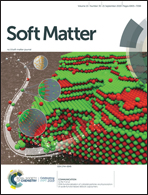A theoretical study on the dynamics of a compound vesicle in shear flow
Abstract
The dynamics of nucleate cells in shear flow is of great relevance in cancer cells and circulatory tumor cells where they determine the flow properties of blood. Buoyed by the success of giant unilamellar vesicles in explaining the dynamics of anucleate cells such as red blood cells, compound vesicles have been suggested as a simple model for nucleate cells. A compound vesicle consists of two concentric unilamellar vesicles with the inner, annular and outer regions filled with aqueous Newtonian solvents. In this work, a theoretical model is presented to study the deformation and dynamics of a compound vesicle in linear shear flow using small deformation theory and spherical harmonics with higher order approximation to the membrane forces. A coupling of viscous and membrane stresses at the membrane interface of the two vesicles results in highly nonlinear shape evolution equations for the inner and the outer vesicles which are solved numerically. The results indicate that the size of the inner vesicle (χ) does not affect the tank-treading dynamics of the outer vesicle. The inner vesicle admits a greater inclination angle than the outer vesicle. However, the transition to trembling/swinging and tumbling is significantly affected. The inner and outer vesicles exhibit identical dynamics in the parameter space defined by the nondimensional rotational (Λan) and extensional (S) strength of the general shear flow. At moderate χ, a swinging mode is observed for the inner vesicle while the outer vesicle exhibits tumbling. The inner vesicle also exhibits modification of the TU mode to IUS (intermediate tumbling swinging) mode. Moreover, synchronization of the two vesicles at higher χ and a Capillary number sensitive motion at lower χ is observed in the tumbling regime. These results are in accordance with the few experimental observations reported by Levant and Steinberg. A reduction in the inclination angle is observed with an increase in χ when the inner vesicle is replaced by a solid inclusion. Additionally, a very elaborate phase diagram is presented in the Λan–S parameter space, which could be tested in future experiments or numerical simulations.



 Please wait while we load your content...
Please wait while we load your content...